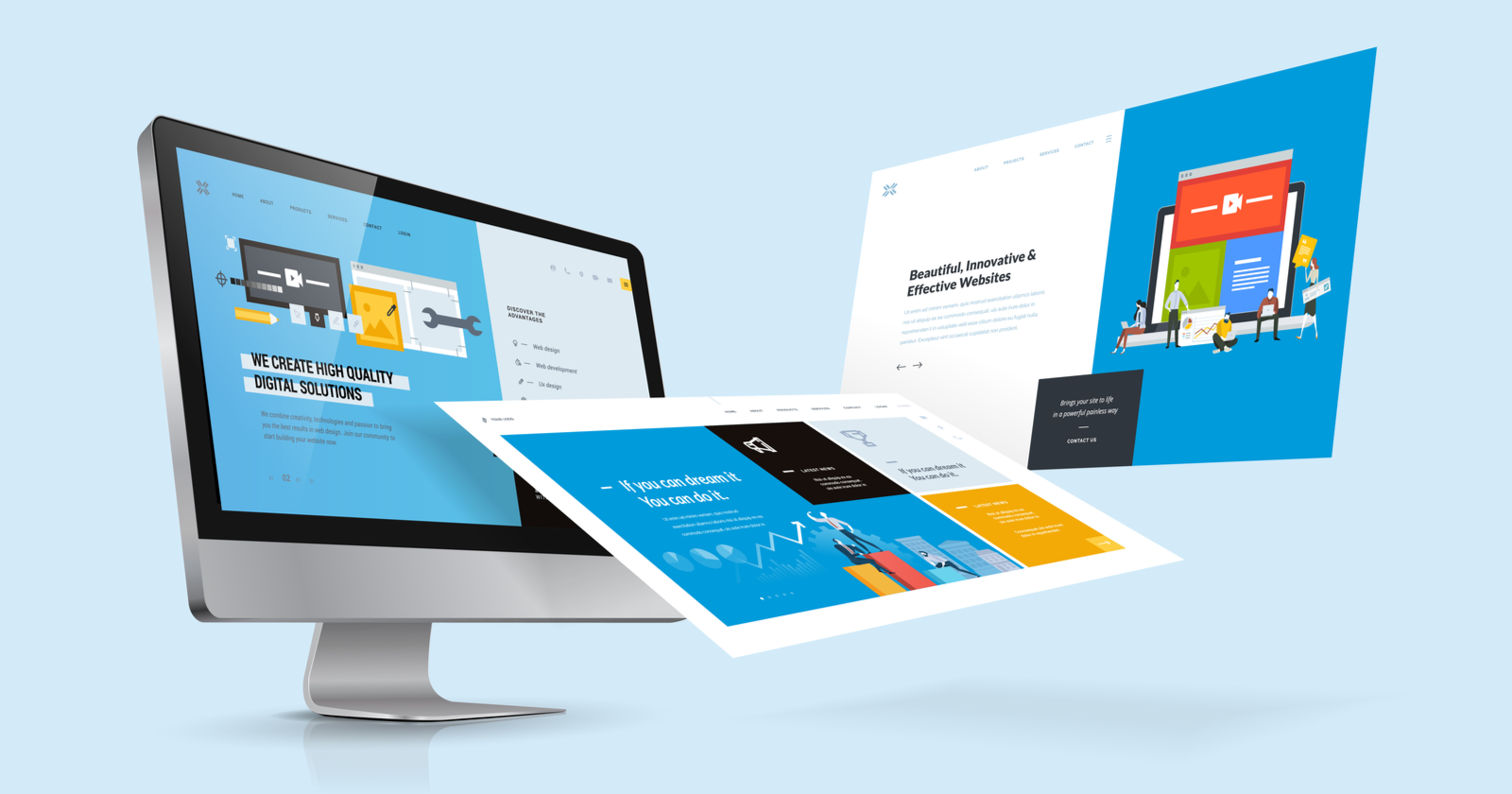Discover why visual hierarchy in website design matters for user experience
Discovering the Uses of Web Layout for Enhancing Individual Experience
Web style significantly influences customer experience across digital systems. By concentrating on user needs, developers produce web sites that are not only aesthetically enticing but additionally practical and available. Crucial element such as responsive design and intuitive navigating play critical functions in enhancing use. Nevertheless, the challenge hinges on understanding just how these parts engage to satisfy advancing individual expectations. The exploration of these aspects reveals insights that can transform electronic engagement.
Comprehending Customer Needs and Assumptions
How can Web developers successfully straighten their developments with individual demands and assumptions? To achieve this, developers must involve in detailed user research study to catch the preferences, behaviors, and discomfort factors of their target audience. Utilizing methods such as studies, meetings, and usability screening, developers collect beneficial understandings that guide their decision-making process.
Developing customer identities can additionally assist in imagining different user segments, ensuring that layout selections reverberate with real customers. Furthermore, designers ought to focus on intuitive navigating and clear phone call to activity, which help with seamless communications.
The Value of Responsive Style
As users significantly accessibility web sites on a variety of gadgets, receptive style has actually become necessary for creating a positive user experience. This strategy permits Web pages to adjust flawlessly to various display sizes, guaranteeing that web content is navigable and quickly readable, despite whether a customer is on a desktop, mobile phone, or tablet computer .
Receptive layout boosts use by offering a constant experience, lowering the need for excessive scrolling or zooming. Additionally, internet search engine favor receptive internet sites, which can enhance a site's presence and reach. This design method also enhances growth initiatives, as it gets rid of the requirement for several versions of a site customized to details tools.
Including receptive style not only satisfies individual expectations but also aligns with modern Web criteria, fostering engagement and contentment. Ultimately, it represents a dedication to ease of access and inclusivity, essential components for any type of successful on-line existence.
Creating User-friendly Navigating
An efficient Web style not only includes responsive designs however additionally focuses on instinctive navigation, which is vital for guiding users via a site seamlessly. Instinctive navigation guarantees that customers can conveniently situate info without unnecessary initiative. Crucial element include a clear food selection structure, sensible categorization of web content, and recognizable icons or tags.
Uniformity in navigating placement throughout various pages cultivates familiarity, boosting user comfort. Using breadcrumb trails enables users to track their place within the site, aiding in backtracking and exploration. On top of that, optimizing navigation for smart phones is fundamental, as numerous individuals accessibility sites by means of tablet computers and smartphones.
Integrating a search bar can additionally improve the individual experience, making it possible for fast accessibility to particular content. Generally, intuitive navigation minimizes disappointment, motivates longer website visits, and ultimately causes greater user fulfillment and engagement. By concentrating on navigation layout, Web developers can greatly enhance the overall user experience.
Making Use Of Aesthetic Power Structure Effectively
Effective website design pivots on the critical usage of aesthetic power structure, guaranteeing that individuals can effortlessly browse material and understand one of the most crucial info at a glimpse. By prioritizing components based upon their relevance, designers can guide users' interest towards critical locations, such as headings, calls-to-action, and vital images.
Strategies such as size, comparison, placement, and color play critical roles in developing this hierarchy. Larger text commonly symbolizes higher importance, while contrasting shades can attract attention to key actions. In addition, consistent placement and spacing assistance create an organized format, making it easier for individuals to refine information rapidly.
Moreover, integrating images tactically can enhance understanding and retention of material. When made use of efficiently, a well-defined aesthetic power structure not only improves usability however additionally enriches the overall individual experience, permitting customers to involve meaningfully with the website's goals.
Enhancing Readability and Access
Visual hierarchy significantly affects exactly how customers connect with a site, however just as essential is ensuring that web content remains available and understandable to all target markets. Effective Web style utilizes clear typography, including appropriate font sizes, line spacing, and contrast to boost readability. Using high-contrast color design can help those with visual impairments, while larger message dimensions profit customers with reviewing troubles. In addition, incorporating alt text for pictures assurances that people making use of screen viewers can access crucial information.
Designers must likewise consider the layout and framework of web content, making use of headings and bullet indicate separate huge blocks of text. This not just help skimming however also aids individuals with cognitive impairments. Ultimately, prioritizing readability and ease of access cultivates an inclusive environment, permitting diverse target markets to engage totally with the site's web content (branding). By addressing these aspects, Web designers can substantially enhance the general user experience
Including Engaging Aesthetic Elements
Including engaging visual aspects is important for improving user experience in website design. Color psychology plays a significant function in affecting users' emotions and habits, while interactive graphics can record attention and urge exploration. With each other, these elements produce an extra appealing and dynamic on-line setting.
Significance of Shade Psychology
The value of color psychology in Web design can not be overstated, as it plays an essential function in forming individual assumptions and behaviors. Shades evoke feelings and can influence exactly how users engage with an internet site. Blue typically communicates depend on and professionalism and trust, making it a prominent option for monetary organizations. Alternatively, red can trigger urgency and exhilaration, usually made use of in sales promos. Comprehending the emotional impacts of color makes it possible for developers to produce a natural aesthetic experience that resonates with users. In addition, regular color pattern improve brand identification and recognition, making certain individuals connect specific shades with particular brands. Inevitably, thoughtful application of shade psychology can significantly enhance individual engagement and complete satisfaction, making it an essential facet of efficient Web design.
Making Use Of Interactive Graphics
Engaging individuals through interactive graphics can considerably enhance their total experience on have a peek here a site. These components, such as animations, infographics, and clickable visuals, foster a deeper link in between individuals and the content. By motivating exploration and participation, interactive graphics can make complicated details more absorbable and preserve users' focus longer. In addition, they give a chance for users to engage with the website in a significant way, leading to raised complete satisfaction and a greater probability of returning. It is important to stabilize interactivity with use; excessively complicated graphics might puzzle customers. Appropriately carried out, interactive graphics can transform an easy watching experience into an appealing trip, ultimately contributing to improved user experience and website performance.
Continuous Testing and Renovation Methods
Continual testing and improvement techniques act as necessary components in enhancing Web style for user experience. By implementing repetitive screening, designers can gather real-time comments on customer communications, enabling them to recognize discomfort factors and areas for improvement - website development. A/B screening, use screening, and heat mapping work techniques that provide insights into individual behavior, allowing educated style decisions
In addition, these approaches encourage a culture of continuous refinement, as opposed to an one-time launch. Web developers can make use of analytics tools to check efficiency metrics, such as bounce prices check here and conversion prices, which assist necessary changes. Normal updates based on individual responses not only enhance performance but likewise foster user contentment and loyalty.
Ultimately, constant screening and improvement create a receptive Web style setting where user experience is focused on, guaranteeing that the site progresses alongside user requirements and technical developments. This aggressive method leads to a more appealing and efficient online existence.
Often Asked Inquiries
How Can Color Psychology Impact Individual Experience in Website Design?
Color psychology greatly influences individual experience in website design by directing and evoking feelings habits. Various shades can develop organizations, improve readability, and impact individual engagement, inevitably shaping understandings of a brand or internet site's performance.
What Function Does Typography Play in Individual Engagement?
Typography greatly affects user engagement by enhancing readability, wikipedia reference developing hierarchy, and conveying brand individuality. Efficient typeface options can capture interest, evoke emotions, and overview users through web content, inevitably enhancing overall communication and complete satisfaction with the web site.

Just How Do Cultural Distinctions Influence Website Design Preferences?
Social differences greatly influence website design preferences, influencing shade selections, images, navigating, and design designs. Comprehending these variants allows designers to develop more relatable and engaging experiences tailored to diverse individual histories and assumptions.

What Tools Can Assist Test Individual Experience Properly?
Different devices, including Google Analytics, Hotjar, and UsabilityHub, effectively test individual experience. These platforms give understandings right into individual habits, promote A/B testing, and collect feedback, assisting designers make educated decisions to boost overall functionality.
Just how Usually Should a Web Site Be Upgraded for Optimal User Experience?
A website needs to be redesigned every a couple of years to preserve perfect user experience. Regular updates assure the style remains contemporary, responsive, and straightened with progressing user needs and technological developments, enhancing general engagement.
Producing user personas can even more help in visualizing different individual sections, guaranteeing that layout selections reverberate with genuine customers. As individuals significantly gain access to sites on a range of tools, receptive design has actually come to be essential for producing a positive user experience. Incorporating engaging visual elements is crucial for enhancing user experience in Web layout. Ultimately, constant testing and improvement develop a receptive Web layout atmosphere where user experience is focused on, guaranteeing that the site advances alongside user requirements and technical developments. Color psychology considerably influences individual experience in Web layout by evoking feelings and directing actions.